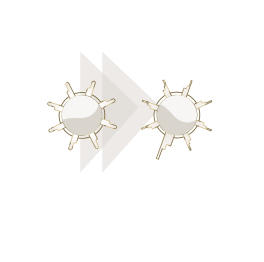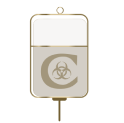INDICATION
TECELRA is a melanoma-associated antigen A4 (MAGE‑A4)-directed genetically
modified autologous T-cell immunotherapy indicated for the treatment of
adults with unresectable or metastatic synovial sarcoma who have received
prior chemotherapy, are HLA-A*02:01P, -A*02:02P, -A*02:03P, or -A*02:06P
positive and whose tumor expresses the MAGE‑A4 antigen as determined by
FDA-approved or cleared companion diagnostic devices.
This indication is approved under accelerated approval based on overall
response rate and durability of response. Continued approval for this
indication may be contingent upon verification and description of clinical
benefit in a confirmatory trial.
IMPORTANT SAFETY INFORMATION
CONTRAINDICATION: DO NOT use TECELRA in adults who are
heterozygous or homozygous for HLA-A*02:05P.
BOXED WARNING: Cytokine release syndrome (CRS), which may be
severe or life-threatening, occurred in patients receiving TECELRA. At
the first sign of CRS, immediately evaluate patient for hospitalization
and institute treatment with supportive care. Ensure that healthcare
providers administering TECELRA have immediate access to medications and
resuscitative equipment to manage CRS.
CRS
-
CRS occurred in 75% of patients (2% Grade ≥3) with a median onset of 2
days (range: 1 to 5 days) and median resolution of 3 days (range: 1 to
14 days). CRS (including Grade 1) was managed with tocilizumab in 55% of
patients who experienced CRS.
-
In patients who experienced CRS, the most common symptoms included
fever, tachycardia, hypotension, nausea/vomiting, and headache.
Immune Effector Cell–associated Neurotoxicity Syndrome (ICANS)
-
ICANS has been observed following administration of TECELRA. One patient
(2%) had Grade 1 ICANS with a median onset of 2 days and resolution of 1
day.
-
ICANS symptoms can include mental status changes, disorientation to time
and place, drowsiness, inattention, altered level of consciousness,
seizures, cerebral edema, impairment of cognitive skills, progressive
aphasia, and motor weakness.
-
Advise patients to refrain from driving and engaging in hazardous
occupations or activities, such as operating heavy machinery or
potentially dangerous machinery for 4 weeks following infusion due to
the potential for neurologic events, including dizziness and presyncope.
Monitoring for CRS and ICANS During and Following TECELRA Infusion
-
Ensure that healthcare providers administering TECELRA have immediate
access to medications and resuscitative equipment to manage CRS and
ICANS. Ensure patients are euvolemic prior to initiating TECELRA.
-
During and following TECELRA administration, closely monitor patients
for signs and symptoms of CRS and ICANS. Following treatment with
TECELRA, monitor patients for at least 7 days at the healthcare
facility. Continue to monitor patients for at least 4 weeks following
treatment with TECELRA. Counsel patients to seek medical attention
should signs or symptoms of CRS or ICANS occur.
-
At the first sign of CRS or ICANS, immediately evaluate patients for
hospitalization and administer supportive care based on severity and
consider further management per clinical practice guidelines.
Prolonged Severe Cytopenia
-
Anemia, neutropenia, and/or thrombocytopenia can occur for several weeks
following lymphodepleting chemotherapy and TECELRA infusion. Patients
with Grade ≥3 cytopenia not resolved by week 4 included anemia (9%),
neutropenia (11%), and thrombocytopenia (5%). The median time to
resolution was 7.3 weeks (range: 6.1 to 8.4 weeks) for anemia, 9.3 weeks
(range: 6.4 to 12.3 weeks) for neutropenia, and 6.3 weeks (range: 6.1 to
6.4 weeks) for thrombocytopenia.
-
Monitor blood counts after TECELRA infusion. Manage cytopenia with
growth factor and blood product transfusion according to clinical
practice guidelines.
Infections
-
Infections may occur following lymphodepleting chemotherapy and TECELRA
infusion and occurred in 32% of patients (14% Grade 3).
-
Do not administer TECELRA to patients with active infections and/or
inflammatory disorders.
-
Monitor patients for signs and symptoms of infection before and after
TECELRA infusion and treat patients appropriately.
-
Febrile neutropenia was observed in patients after TECELRA infusion and
may be concurrent with CRS. In the event of febrile neutropenia,
evaluate for infection and manage with broad-spectrum antibiotics,
fluids, and other supportive care, as medically indicated.
-
Viral reactivation has occurred in patients following TECELRA. Perform
screening for Epstein-Barr virus, cytomegalovirus, hepatitis B virus,
hepatitis C virus, and human immunodeficiency virus (HIV) or any other
infectious agents if clinically indicated. Consider antiviral therapy to
prevent viral reactivation per local guidelines.
Secondary Malignancies
-
Patients treated with TECELRA may develop secondary malignancies or
recurrence of their cancer. Monitor for secondary malignancies.
Hypersensitivity Reactions
-
Serious hypersensitivity reactions, including anaphylaxis, may occur due
to dimethyl sulfoxide (DMSO) in TECELRA. Observe patients for
hypersensitivity reactions during infusion.
Potential for HIV Nucleic Acid Test False-Positive Results
-
The lentiviral vector used to make TECELRA has limited, short spans of
genetic material that are identical to HIV. Therefore, some commercial
HIV nucleic acid tests may yield false-positive results in patients who
have received TECELRA.
Adverse Reactions
-
Most common adverse reactions (incidence ≥20%) were CRS, nausea,
vomiting, fatigue, infections, pyrexia, constipation, dyspnea, abdominal
pain, non-cardiac chest pain, decreased appetite, tachycardia, back
pain, hypotension, diarrhea, and edema.
-
Most common Grade 3 or 4 laboratory abnormalities (incidence ≥20%) were
lymphocyte count decreased, neutrophil count decreased, white cell blood
count decreased, red blood cell decreased, and platelet count decreased.
-
Most common serious adverse reactions (≥5%) were cytokine release
syndrome and pleural effusion.
INDICATION
TECELRA is a melanoma-associated antigen A4 (MAGE‑A4)-directed genetically
modified autologous T-cell immunotherapy indicated for the treatment of
adults with unresectable or metastatic synovial sarcoma who have received
prior chemotherapy, are HLA-A*02:01P, -A*02:02P, -A*02:03P, or -A*02:06P
positive and whose tumor expresses the MAGE‑A4 antigen as determined by
FDA-approved or cleared companion diagnostic devices.
This indication is approved under accelerated approval based on overall
response rate and durability of response. Continued approval for this
indication may be contingent upon verification and description of clinical
benefit in a confirmatory trial.
Please see full Prescribing Information, including Boxed Warning.
References: 1. TECELRA. Prescribing information. Adaptimmune; 2024. 2. Wang T, Navenot JM, Rafail S, et al. Mol Ther Methods Clin Dev. 2024;32(2):101265. doi:10.1016/j.omtm.2024.101265 3. Data on file. Adaptimmune. 4. Leukapheresis Manual. Adaptimmune; 2024. 5. Reddy V, Winston NR. StatPearls Publishing. 2024:1‑11.


 step1
step1

 step2
step2
 step3
step3
 step4
step4

 step5
step5

 step6
step6

